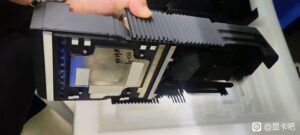
Photos of a heatsink allegedly belonging to NVIDIA’s yet unconfirmed GeForce RTX 4090 seem to have made their way on to the internet. The pictures were first leaked on to the Chinese PC hardware site, Chiphell and give us a glimpse of what we could expect for the next-generation GPU.
At the time of this publication, the post on Chiphell has since been removed, but not before several sites were able to save the images. Assuming the photos are real, it is safe to say that the cooler shroud cum heatsink of the RTX 4090 is huge and, at a glance, virtually identical in design to the RTX 30 Series Founders Edition heatsink design.

For that matter, the photos also indicate that NVIDIA plans on retaining the same PCB design, as well as its dual-axial fan design. Upon further inspection, we can also see that, while the heatsink design is the same, the one seen here clearly has more fins than the current one.
We can also see that the contact block for the GPU is also significantly larger; a supposed indication of the increase in size of the RTX 4090’s GPU.


Online rumours and speculations have suggested that NVIDIA’s RTX 40 Series, its architecture named Ada Lovelace, is expected to pull 600W off the wall, and that’s just for its higher-end cards. The RTX 4090, in particular, is also expected to offer 16128 CUDA cores and 21 Gbps GDDR6X memory, although the total amount of graphics memory remains a mystery.

Getting back on track, we should point out that the quality of the photos aren’t the greatest quality, so the authenticity of these photos are definitely questionable and should be treated with skepticism. Guess we’ll just have to wait until the supposed July or August launch window, if the most recent rumours are to be believed.
(Source: Chiphell via Videocardz)
The post Alleged NVIDIA GeForce RTX 4090 Heatsink And Cooler Shroud Leaks appeared first on Lowyat.NET.